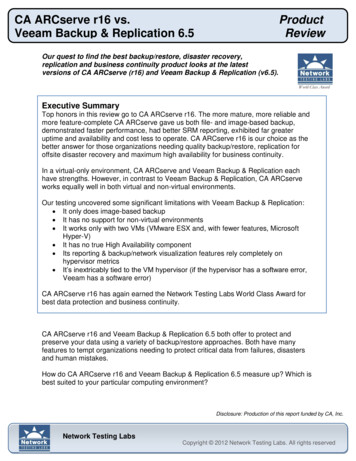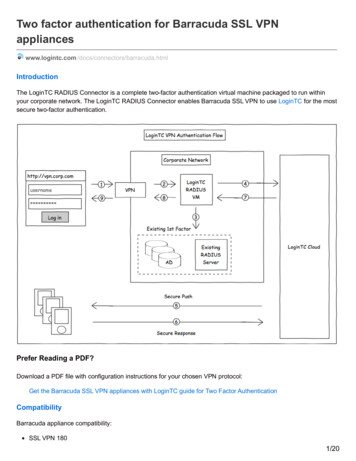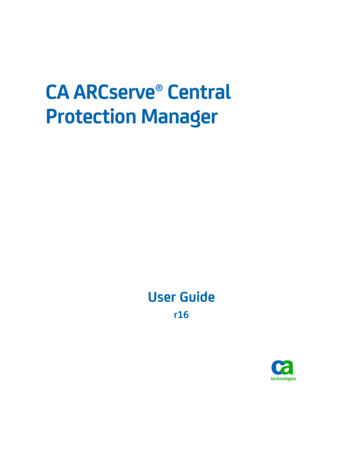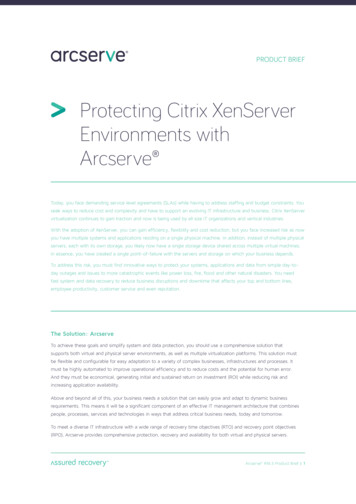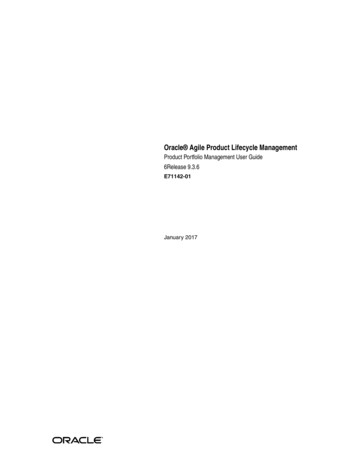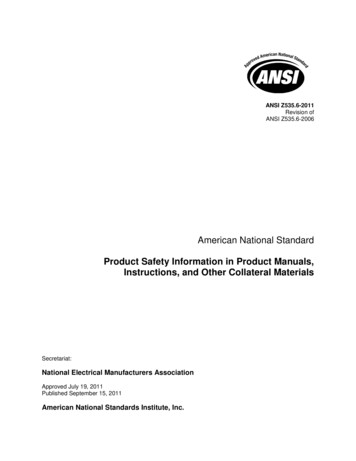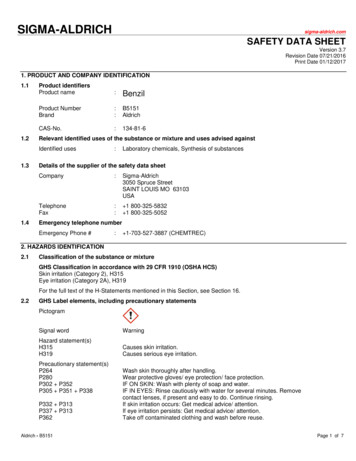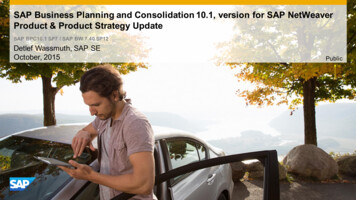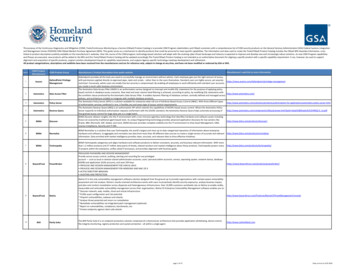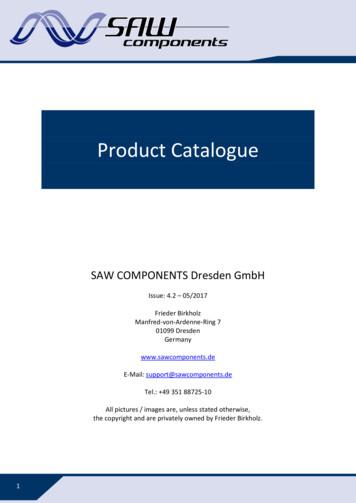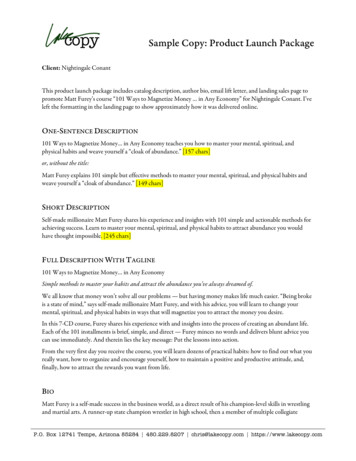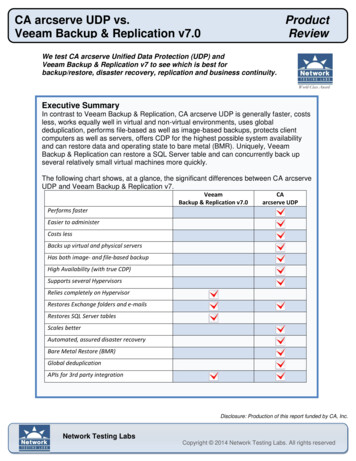
Transcription
CA arcserve UDP vs.Veeam Backup & Replication v7.0ProductReviewWe test CA arcserve Unified Data Protection (UDP) andVeeam Backup & Replication v7 to see which is best forbackup/restore, disaster recovery, replication and business continuity.Executive SummaryIn contrast to Veeam Backup & Replication, CA arcserve UDP is generally faster, costsless, works equally well in virtual and non-virtual environments, uses globaldeduplication, performs file-based as well as image-based backups, protects clientcomputers as well as servers, offers CDP for the highest possible system availabilityand can restore data and operating state to bare metal (BMR). Uniquely, VeeamBackup & Replication can restore a SQL Server table and can concurrently back upseveral relatively small virtual machines more quickly.The following chart shows, at a glance, the significant differences between CA arcserveUDP and Veeam Backup & Replication v7.VeeamBackup & Replication v7.0CAarcserve UDPPerforms fasterEasier to administerCosts lessBacks up virtual and physical serversHas both image- and file-based backupHigh Availability (with true CDP)Supports several HypervisorsRelies completely on HypervisorRestores Exchange folders and e-mailsRestores SQL Server tablesScales betterAutomated, assured disaster recoveryBare Metal Restore (BMR)Global deduplicationAPIs for 3rd party integrationDisclosure: Production of this report funded by CA, Inc.Network Testing LabsCopyright 2014 Network Testing Labs. All rights reserved
CA arcserve UDP vs.Veeam Backup & Replication v7.0ProductReviewNote that our testing and analysis uncovered some high-level, significant limitations withVeeam Backup & Replication: It only does image-based backup It is intended for and only works in and with virtual environments It supports just two hypervisors (VMware and, with fewer features, Hyper-V) It has no High Availability component Its reporting & backup/network visualization features rely completely onhypervisor metrics It’s inextricably tied to the VM hypervisor (if the hypervisor has a software error,Veeam has a software error)In this report, we look closely and in detail at the abilities and shortcomings of both CAarcserve UDP and Veeam Backup & Replication v7.0. We compare and contrast thetwo products, feature by feature.CA arcserve UDP is a single product with a licensing structure that unlocks suchfunctions as replication and high availability.Veeam Backup & Replication’s components include the core Veeam Backup &Replication tool, Veeam ONE (reports), Veeam Management Pack (Microsoftmonitoring helper module) and Veeam Smart Plug-in (SPI) (HP monitoring helpermodule). Veeam also offers some no-charge, limited-function, promotional versions:Veeam Backup Free Edition, Veeam ONE Free Edition, Veeam Extended GRL andVeeam Stencils (for Visio).Veeam offers its backup/recovery tool in three editions: Standard, Enterprise andEnterprise Plus. These editions vary mainly in features, user interface and how manyCPU sockets each supports.CA arcserve UDP’s significant features include: Recovery Point Server (RPS) – CA arcserve UDP’s brain. Generates catalogs,deletes expired backups, stores backup data sets, replicates data to other RPSmachines, manages backup and restore operations and supervises CA arcserveReplication and High Availability operations. Data Deduplication – An RPS can optionally use deduplication to save diskspace by storing just a single copy of duplicate data in a backup. Integrated Replication – On a continuous basis, each RPS can optionallymaintain multiple copies of backup data via replication. These backup dataNetwork Testing LabsCopyright 2014 Network Testing Labs. All rights reserved
CA arcserve UDP vs.Veeam Backup & Replication v7.0 ProductReviewcopies are available for virtually instantaneous use on secondary servers if aprimary server fails.Microsoft Hyper-V Support – Agentless backup of data on Hyper-V virtualmachines, with support for Virtual Standby (see below), incremental backups,data compression and data deduplication.VMware vSphere Support – Agentless backup of data on VMware vSpherevirtual machines, with support for Virtual Standby (see below), incrementalbackups, data compression and data deduplication.Windows and Linux Clients – Uses a small agent to back up Windows or Linuxclient (workstation) data (physical or virtual).Backup Plans – Easy-to-administer named policies that specify exactly how tomake backup copies of your data. Each plan contains instructions for copyingdata, replicating data, making secondary and tertiary copies of data (typicallyoffsite), setting up and maintaining Virtual Standby machines and notifyingadministrators that a backup job succeeded or failed.RPS Share Plan – Establishes client backup plans, maps multiple Windowsusers to a plan and shares the plan with remote RPS machines.Multiple Data Store Options – CA arcserve UDP can store data on a local disk,a remote file server, a virtualized storage device or a NAS device. Compression,global data deduplication and strong encryption are settable options.Sophisticated Scheduling – Performs backup, merge, retention and replicationtasks when and how you specify.Virtual Standby -- Maintains an up-to-date standby (secondary) virtual serverthat can instantly replace a failed primary server in either physical-to-virtual (P2V)or virtual-to-virtual (V2V) mode. Automated or manual failover.Useful Reports – CA arcserve UDP tells administrators the current status andhealth of backup jobs and backup environment with such details as ManagedCapacities, Backup Sizes, Backup Status, Virtualization Protection Status andData Distribution on Media.Multi-layer Data Recovery Options – Recover data for an application, a specificfile, an entire file system or a VM. Instant volume-level recovery for Linux.Exchange Granular Restore – Recover mail for an account, an account’s mailfolder, a single mail item or an entire Exchange system.Bare Metal Recovery (BMR) – Restores a Windows or Linux computer’scomplete operating environment, including files, settings and operating system,to a different hard disk, to a similar but different computer or to even a dissimilarcomputer.Copy File or Recovery Point – Saves extra copies of a particular file or anentire recovery point to the specified disk or cloud destination(s) for added dataprotection.RPS Jumpstart – Move large data stores to a new remote RPS via externaldevice (e.g., USB flash drive memory).Network Testing LabsCopyright 2014 Network Testing Labs. All rights reserved
CA arcserve UDP vs.Veeam Backup & Replication v7.0ProductReviewThe new features in Veeam Backup & Replication v7.0 are:Two “Disruptive Innovations” (Veeam’s own terminology) Pre-programmed WAN acceleration, consisting of caching, variable block lengthdata fingerprinting and TCP/IP protocol optimizations (requires the EnterprisePlus edition) VMware-only SAN device remote control feature for creating snapshots in 3 HPSAN environments (HP StoreVirtual VSA, HP StoreVirtual and HP StoreServ)(requires the Enterprise Plus edition)Miscellaneous New Backup & Replication Features Tape drive support (requires Enterprise or Enterprise Plus edition) SureReplica for verifying restore points in replicas (VMware-only, requiresEnterprise or Enterprise Plus edition) vCloud Director enhanced visibility of backups (requires Enterprise or EnterprisePlus edition) vSphere Web Client plug-in for monitoring backups (requires VMware vSphere5.1) vSphere 5.5 support Windows Server 2012 R2 support SureBackup, U-AIR and On-Demand Sandbox for Hyper-V (Requires WindowsServer 2012 Hyper-V plus Veeam’s Enterprise or Enterprise Plus edition) Can delegate 1-Click Restore functions (Enterprise Manager Web interface),including the restoration of entire VMs, across multiple administrators andbusiness users (requires Enterprise Plus edition) Explorer for Microsoft SharePoint has advanced search capabilities and granularrecovery of SharePoint database items (requires Microsoft SharePoint 2010 andVeeam’s Enterprise or Enterprise Plus) Support for Microsoft Exchange 2013 Additional enhancements, such as:o the ability to set independent retention policies for each backup job or backupcopy jobo parallel processing of multiple VMso support for larger backupso automatic termination of deduplication when the Veeam software sees largebackup files that are not a good candidate for deduplicationThe categories we used in this evaluation are Ease of use and overall features Pricing Image-based backup featuresNetwork Testing LabsCopyright 2014 Network Testing Labs. All rights reserved
CA arcserve UDP vs.Veeam Backup & Replication v7.0ProductReview File-based backup features Replication/high availability featuresThe first section contrasts CA arcserve UDP and Veeam Backup & Replication for easeof use and overall features.Ease of Use and Overall FeaturesCA arcserve UDP has a new, sophisticated Web-based user interface, the UnifiedManagement Console (UMC). The UMC is a single pane through which administratorsmanage, direct and control the entire breadth of CA arcserve UDP functions. The UMCis task-based, simple to use, intuitive, easy to navigate and responsive. It offers onestep-at-a-time, guided wizards for everyday operations, reporting functions, creating anew RPS, establishing backup/recovery policies and other tasks. With the UMC, anadministrator is never more than a mouse-click away from seeing backup statusinformation, producing reports, adjusting a backup schedule, or – if need be – restoringa computer to a known-to-be-good, running state.With the UMC, an administrator can easily see and manage all servers and clients. Heor she can even use a mobile device to access the UMC. As an extra bonus, acarefully-designed, well-documented programmatic interface is available that MSPs andlarge enterprises can use to quickly and surely integrate CA arcserve UDP into anexisting complex data center environment.Data visibility is crucial to data backup reliability. CA arcserve UDP’s well-formatted andconfigurable dashboard reveals, at a glance, the current status of your backups. And,with a single click, CA arcserve UDP displays clear and highly descriptive graphicaldetails regarding backup sets and backed up data.In contrast to CA arcserve UDP’s advanced-technology Web-based interface, VeeamBackup & Replication uses Microsoft design standards and Microsoft user interfaceguidelines to present a tree view of backup sets and objects. Veeam Backup &Replication’s user interface is not as intuitive or as responsive as CA arcserve UDP’s.Also note that you must have at least one VM actively running in order to administerVeeam Backup & Replication.Veeam Backup & Replication can show a configurable dashboard display ofbackup/restore status information. However, with Veeam Backup & Replication,visualizing backup status requires more navigations steps. And navigating and selectingVeeam Backup & Replication’s reports, we found, is labor-intensive.If you have multiple site backups, both CA arcserve UDP and Veeam Backup &Replication consolidate and centralize backup status information from all sites.Network Testing LabsCopyright 2014 Network Testing Labs. All rights reserved
CA arcserve UDP vs.Veeam Backup & Replication v7.0ProductReviewThe overall feature set of CA arcserve UDP far exceeds that of Veeam Backup &Replication. CA arcserve UDP has global deduplication, assured recovery, built-inreplication, full system high availability/failover, optimized bandwidth usage, betterscalability, client/workstation protection, BMR and a comprehensive set of APIs for 3rdparty integration.Veeam Backup & Replication does offer a programmatic interface, but it lacks theseother features.If you have a hybrid physical-and-virtual environment, Veeam Backup & Replicationforces you to license two different vendor’s backup and recovery products – onephysical, the other virtual. The two-vendor approach doesn’t make sense because it’smore expensive and less productive. Veeam Backup & Replication’s “Total Cost ofOwnership” (TCO) is always going to be higher than if you’d licensed yourbackup/recovery from a single vendor.CA arcserve UDP is a single answer for IT organizations that need both physical serverand virtual server backup and recovery. It offers image- and file-based backup,replication and true high availability for both physical and virtual environments. UnlikeVeeam Backup & Replication, CA arcserve UDP can backup Windows-based clients(workstations).Veeam Backup & Replication only supports virtual servers (and then only VMware andHyper-V). Moreover, Veeam Backup & Replication is purely image-based.Notably, CA arcserve UDP’s Virtual Standby feature can convert backups from bothphysical and virtual servers to VMs for near instantaneous recovery. Veeam Backup &Replication’s server-to-server data exchanges, even for its Instant Recovery feature,must occur strictly within a virtual environment.CA arcserve UDP’s BMR can easily recover an entire Linux or Windows machine(server or client), including hidden Registry files and system status information, thusputting a computer quickly back to work even after a hard drive failure. Furthermore, CAarcserve UDP’s BMR can restore data from physical and virtual servers onto dissimilarhardware (P2P, P2V, V2P and V2V). Veeam Backup & Replication operates only in thevirtual world and cannot perform BMR.Because it spans physical and virtual environments, CA arcserve UDP offers bothphysical-to-virtual and virtual-to-physical replication and high availability. Veeam Backup& Replication lacks these capabilities. Impressively, CA arcserve UDP’s image-basedbackup and high availability functions can be used to quickly and easily performphysical-to-virtual migrations. Veeam Backup & Replication lacks this capability, too.Network Testing LabsCopyright 2014 Network Testing Labs. All rights reserved
CA arcserve UDP vs.Veeam Backup & Replication v7.0ProductReviewCA arcserve UDP’s support for both physical and virtual environments extends into thecloud – including physical-to-cloud backup migration, replication and high availability.Veeam Backup & Replication also lacks these features.Global deduplication – At your option, CA arcserve UDP stores only a single copy ofenterprise-wide duplicate data. The “to-all-employees” e-mail messages that everyonesaves copies of, the widely-distributed documents that people file away, the videos thatpeople like to archive and the common application files that each user has are all goodexamples of across-the-company duplicate data.CA arcserve UDP maintains a global index of duplicate data. Whether the duplicatedata consists of just a few users’ files in one location or is spread across New York,Chicago, Los Angeles, Sydney, Tokyo, Hong Kong, Shanghai, Mumbai, Tel Aviv, Cairo,Athens, Berlin, Paris and London – CA arcserve UDP globally deduplicates your data. Itcarefully notes the duplicate data’s different locations in its deduplication database,which CA arcserve UDP distributes among the various RPS servers. We found anotherfeature particularly appealing: CA arcserve UDP can store its deduplication database onSolid State Disks (SSDs). The result is improved performance and reduced bandwidthutilization. Furthermore, CA arcserve UDP secures the deduplication process withencryption and per-session passwords.Veeam Backup & Replication’s deduplication is local, working on only one node at atime.Automated Disaster Recovery (DR) and Assured Recovery – You can instruct CAarcserve UDP to automatically fail over to an alternate set of servers (likely at a remotesite or hosting provider) when disaster strikes. Without disrupting your business or theflow of data in your organization, CA arcserve UDP will even periodically test thefailover process. The test produces a detailed report that you (and compliance auditors)can use as evidence of system recoverability. Quick, worry-free disaster recovery is ahallmark of CA arcserve UDP.Replication – CA arcserve UDP can send a copy of each and every data output (i.e.,write) operation to a secondary destination. The replication destination can be, forexample, a separate RPS, a secondary server or a cloud. The replication destination isan instantly-available secondary resource in case of disaster. Intelligently, CA arcserveUDP uses compression, encryption, WAN optimization and bandwidth throttling to giveyou control over the replication process, including network bandwidth utilization andthus costs. The replication feature uses HTTP tunneling to avoid firewall and NetworkAddress Translation (NAT) issues. CA arcserve UDP can replicate in a one-to-one, one-Network Testing LabsCopyright 2014 Network Testing Labs. All rights reserved
CA arcserve UDP vs.Veeam Backup & Replication v7.0ProductReviewto-many or many-to-one fashion. CA arcserve UDP keeps the replicated server(s)perfectly synchronized with the primary (source) server(s).High Availability/Failover – CA arcserve UDP’s HA achieves virtually 100% uptime forservers you designate by monitoring applications and background services running on aserver. If a service fails, CA arcserve UDP attempts to restart it. If the restart fails, thesystem can be set to automatically fail over to a replica (or failover) server. Alternately,the administrator can set the system to not automatically failover, thus allowing theadministrator to investigate the problem. The administrator can then choose to usemanual push-button failover.CA arcserve UDP can monitor a single server, group of servers, server farm or specificapplications, such as Microsoft Exchange, SQL Server, SharePoint, IIS and DynamicsCRM, thus ensuring maximum availability. When a hardware or application failureoccurs, CA arcserve UDP activates the replica server(s). It gives the replica servers IPaddresses and host names during activation to make failover transparent to end users,many of whom will never even know the failover happened.Scalability – CA arcserve UDP’s architecture is eminently scalable. To save money, asmall company might add RPS functionality to an existing file server. At the other end ofthe spectrum, a large enterprise might install individual CA arcserve UDP elements on avariety of dedicated servers throughout the organization’s data centers. CA arcserveUDP can support any server or application topology.APIs for 3rd party integration – Managed Service Providers (MSPs) and largeenterprises can easily integrate CA arcserve UDP into their existing organizationalstructures via a comprehensive, simple-to-use and clearly documented Web-APIprogrammatic interface. In a similar manner, Veeam Backup Enterprise Managerexposes its objects via a programming protocol based on the REST (RepresentationalState Transfer) framework.PricingThe following tables show Veeam’s and CA’s prices for Backup & Replication and CAarcserve UDP. Both products include one year of maintenance.While the two fee schedules are structured somewhat differently, our analysis revealsthat Veeam Backup & Replication costs more yet provides far fewer features than CAarcserve UDP.For instance, the a la carte purchase of just a single 6-CPU-socket server license ofVeeam Backup Management Suite Enterprise edition will cost you 9,300. In contrast,CA arcserve UDP Premium Edition for a 6-CPU-socket server is only 7,170.Network Testing LabsCopyright 2014 Network Testing Labs. All rights reserved
CA arcserve UDP vs.Veeam Backup & Replication v7.0ProductReviewVeeam Backup & Replication v7.0Cost per CPU socket(includes 1 year of non-premium support)StandardEnterpriseEnterprise PlusVeeam Backup & Replication 750 1,250 1,999Veeam Backup Essentials 410 750 1,150 1,100 1,550 2,300Veeam Backup Management SuiteTwo years of Veeam Backup & Replication premium support optionally costs 567.CA arcserve UDPMSRPCA arcserve Unified Data Protection Standard
In contrast to CA arcserve UDP’s advanced-technology Web-based interface, Veeam Backup & Replication uses Microsoft design standards and Microsoft user interface guidelines to present a tree view of backup sets and objects.
